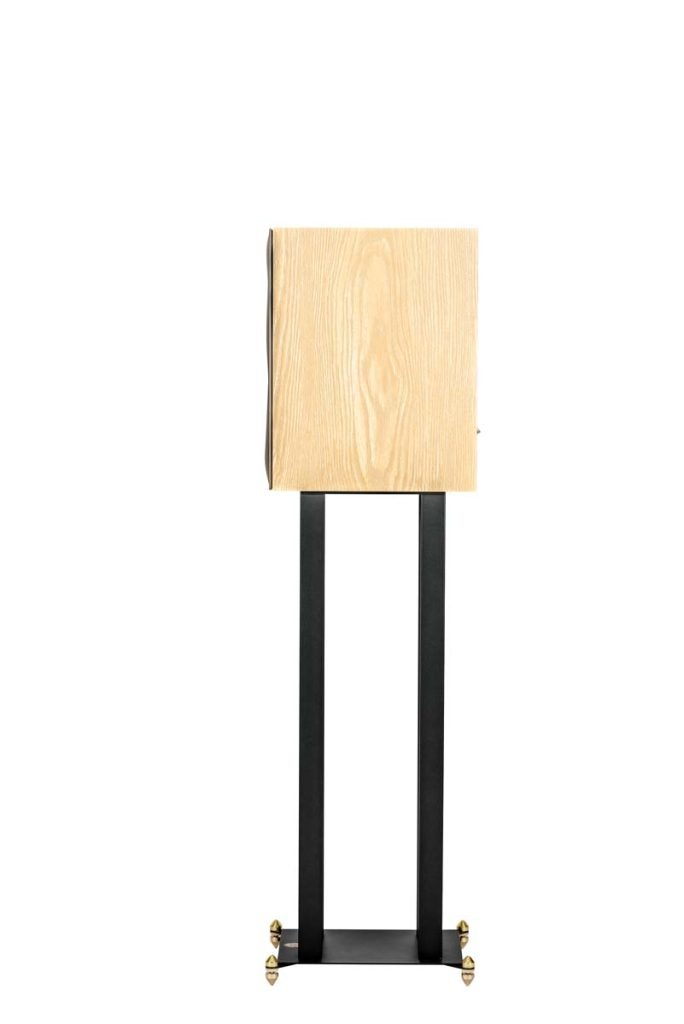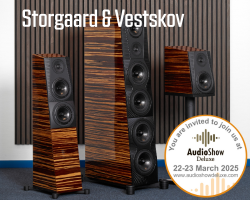REVIVAL AUDIO SPRINT 3 LOUDSPEAKERS REVIEW
At less than £1000 Revival Audio’s Sprint 3 standmount loudspeakers are in a competitive market. Stuart Smith takes a listen.

Revival Audio launched its brand in 2021 and is based in Alsace in the East of France where its range of loudspeakers is built. Revival is headed up by Daniel Emonts, an engineer in the HiFi industry for more than 30 years, where he has worked with Focal and Dynaudio, and Jacky Lee, a Swiss-based Taiwanese Strategist Executive, who has worked with Dynaudio, IBM, and L’Oréal. When I reviewed the Revival Atlante 5 speakers I hinted that Revival was setting out to shake things up a bit in the audio world and given their presence at shows we visit, it seems that they have done just this and have distribution deals in many markets. I’ll lift this next comment from the review I linked to as I think it’s an interesting way to go for a HiFi brand: The company offers “A customer-centric community with exclusive benefits”. This latter point gives you a 45 try-at-home program allowing you to make your mind up about the speakers in your system and your own listening space. It also gives you free delivery in the EU and the UK and a TEN-YEAR warranty. In truth, there’s not a lot to go wrong with loudspeakers but this ten-year warranty certainly puts the company’s proverbial money where its mouth is and offers buyers and potential buyers a good degree of peace of mind when making purchasing decisions.

WHY A STANDMOUNT?
There’s no denying that stand-mounted loudspeakers (when you include the stand) take up as much floor space as a pair of floor-standers so the natural question would be “Why bother with a pair of stand-mount when you could get a pair of floor-standing speakers that are likely to go lower without taking up any more space. My personal view on this is that in some spaces a smaller stand-mount, with its naturally compromised bass response may well be the better option in smaller spaces and particularly where nearer-field (mid-field) listening is the only option. From a personal taste perspective, I also enjoy the way a very good stand-mount speaker images. Now, with all that said, given the choice in a larger space, I’d go for floor-standers every time.
SPRINT
The Revival Audio SPRINT series of speakers (there is the stand-mount speaker we are looking at in this review and a floor-stander) aims to be an affordable range of speakers, with the SPRINT 3 costing 999 Euros and the SPRINT 4 costing 1799 Euros with the UK price being very similar…but with a £ sign in front of it.
Like the ATALANTE speakers I reviewed, the SPRINT is designed in collaboration with Le French Design 100 Award-winning studio A+A Cooren Design, based in Paris. The speakers certainly do look very nice.


DESIGN AND TECHNOLOGY OF THE REVIVAL AUDIO SPRINT 3 LOUDSPEAKERS
The first thing that will strike you about this speaker is the front baffle which is a lovely-looking shape, but that form follows function. Revival Audio calls the front baffle ELYTRON and it can be removed as it’s attached by magnets with fabric grills being attached from behind. It’s an asymmetric shape and quite curvy, with the curves acting as wave-guides to enhance high-frequency directivity. It is also designed to enhance mid and low-frequencies by reducing the diffraction impact of the MDF cabinets. From a design perspective alone I think the ELYTRON baffle enhances the aesthetics of the SPRINT 3 speakers. I’d assumed the ELYTRON baffle would be glued onto the front of the speakers, but true to Revival’s word, they do come off and attach very easily.
The speakers are pretty hefty at 9.1Kgs each and are a reasonable size too (380mm x 213mm x 307mm (HWD). They come in a variety of colours; Walnut, Blonde Oak, and Matte Black and the speakers we were sent for review arrived in an attractive Blonde Oak. It’s certainly a good-looking loudspeaker.
The SPRINT 3 is a two-way, bass-reflex design with 28mm soft-dome tweeter and an 18cm Basalt Sandwich Construction (BSC) woofer.
Revival calls the tech the tweeter on this speaker has ARID+ (Anti Reflection Inner Dome) technology, and it is designed to absorb around 95% of resonance in the chamber. It also uses asymmetrical suspension, which is used to lower resonance and give better dispersion. Another design feature of the tweeter is that is uses Back Chamber Damping (BCD), where the back cover of the tweeter has asymmetric rims to absorb resonances and which manages to get the resonance frequency down to 560Hz. Reading the notes about this speaker it becomes clear that there’s clearly a lot of thought gone into the design of this tweeter and with specific emphasis on reducing resonances.
As readers with an interest in loudspeaker design will be aware, the goal of most designs of woofers is to be light and stiff. With this in mind, Revival uses a Basalt Sandwich Construction (BSC) that they say offers similar characteristics to glass fibre but with a better Young’s Modulus – a mechanical property of solid materials that measures the tensile or compressive stiffness when force is applied lengthwise (thanks Wiki). The woofer is made of 3 layers; a basalt membrane, a special felt, and a polymer glue in the middle to bind them together.
From a specifications perspective the SPRINT 3 will of down to 55Hz, are 87dB sensitive, offer a nominal impedance of 6 ohms, and crossover at 1.8KHz. Their bass reflex port is on the back, and they are recommended for rooms from 15 to 35m square.
What I like so far with the construction and design is that it looks good, and rather than it simply being a box with off-the-shelf components bolted on, it’s a loudspeaker with a good deal of thought put into it’s design.
Packaging for the speakers was excellent with them coming double boxed and then inside plastic and fabric covers – the fabric covers could be used to protect the speakers in day-to-day use if you see the need.
The speakers come with a set of rubber disc feet that bolt onto the bottom of the speakers should you wish to stand them on a shelf, unit, or your own stands.
The SPRINT 3 speakers came with an optional pair of stands in the form of the Revival Audio STAND 3. They are heavy (5.6Kg) and stand about 60cm high. They bolt together and the speakers then bolt to the top plate with the rubber discs between the speaker and stand – I like this as it reduces the risk of the speakers being knocked off their stands. That said, I don’t recall ever having knocked a pair of speakers off their stands! The stands are an optional extra and will add a further 399 Euros to the price of the speakers. You can, of course, use speaker stands you already have. I found the stands a bit of a faff to put together and equally the speakers to bolt on to them. All in it took me pretty much bang on an hour to assemble them, but I suppose once you have it done, it’s done.


SOUND OF THE SPRINT 3 BY REVIVAL AUDIO
I used the Electrocompaniet AW 800M power amplifier (just one running in stereo) with the Vinius TVC-05 preamplifier being fed by from the Lampizator DAC for the majority of this review, though I did play a few vinyl records through them too – for the sake of this review I’m referring only to files played digitally. The amp is perhaps a little overkill given the very acceptable price of these speakers, but they seemed to work well with the amp when I set them up for run-in so I stuck with it. For run-in, I Djd through these speakers for a week or so – I usually do this at volume and so I reckon it’s a pretty good way to loosen a speaker up.
The speakers were place about 3m apart, slightly toed in and in free space – well away from either back walls or side walls.
Regular readers of my reviews will know that I talk about bass quite a bit when reviewing (particularly) speakers and I confess that I was a bit worried by the quoted 55Hz low. I needn’t have been, as when I sat down to listen Roon played what I’d been listening to previously and that was Bob Marley and The Wailers’ Exodus record – we’d just watched the brilliant Marley Biopic and so were on a bit of a reggae marathon. On the title track (7” version) the bass guitar was easy to follow and quite forward in the mix – not overblown, but well-evident. Not as tight as with our Audiovector R6 and obviously not as deep, but really, there was nothing to complain about in the bass department with this particular record. You do get a pair of bungs to save into the bass ports should you need to position closer to a wall and avoid bass-bloat – a useful thing to include. In honesty, I don’t think these speakers are far off our Xavian Perla’s in the bass and for a lot less money.
Tightness in the bass is something I go on about a fair old bit with flabby bass being a bit of a bug-bear of mine. The SPRINT 3’s do not have a flabby bass, even on this kind of reggae that can be quite challenging.
Smoke On The Water (Deep Purple) off the Made In Japan record is a bit of a test of mine for bass – that well-worn guitar riff, the hats, and then the bass comes in. The SPRINT 3s find this track a bit more of a challenge and compared to our references there is a slight muddying in the bass and it gets a little lost in the mix – It’s not quite as guttural as I am used to with our bigger Audiovectors. However, perhaps I’m hoping for a bit much for a speaker that only goes down to 55Hz.
Back to some Dub (Syndicate) and the opening track to the brilliant Strike The Balance record and I’m a happy piglet again. The bass guitar is full, tight, and where it should be in the mix. This track is much simpler in regards to the amount of stuff that is going on in the tune when compared to the Depp Purple track, and it’s better mixed than the live recording. You can see in your minds eye the bass player’s finger ends “walking” the strings and the other hand moving on the fretboard.
Back to something a bit more rocky in the form of the Jam and Setting Sons. I’ve always loved Bruce Foxton’s bass playing and the way it plays off Rick Buckler’s tight drumming and it comes across well on Thick As Thieves though the SPRINT 3s. Perhaps I’d have liked it to be a bit more evident in the mix and a bit lower, but it was easy enough to follow and the bass/drum interplay was a joy. Overall for a speaker of this size and its obvious limitations with regards to bass extension, I enjoyed being drawn into the bass of this record which took me back to listening over and over to this record in my bedroom when I was a teenager.
I’ve become a tiny bit obsessed but the track Sadness As A Gift by Adrianne Lenker from her Bright Future album. It’s a wonderful country record that I urge you to have a listen to, though it’s a bit of a diversion from my usual route on the musical highways and byways. It’s a very live-sounding recording that sounds like it’s been played “as a band” rather than players doing their parts in isolation in the studio. Her vocal comes across front and forward and beautifully nuanced. The male backing vocal that comes in on the chorus is also presented as I suspect it was intended to by the engineer. I would say that this clarity of vocals, particularly on simpler program is a bit of a strong point of these loudspeakers with the slight vibrato on Lenker’s voice being very evident – beautiful and I could have listened to this record over and over on these speakers. The same is true when listening to David Crosby’s Coz and any other relatively simple music (Emiliana Torrini, for example) where the vocal is to the fore. They certainly allow the full expression, nuance, and detail of a well-recorded vocal into the room and I find myself being drawn to the likes of Gil Scott-Heron and others throughout my time with these speakers. This sounds like I’m suggesting these are a bit of a one-trick pony pair of speakers, but rather I’d suggest that they just play this kind of music exceptionally well – if this is your bag, then look no further at this price!
As a bit of a diversion I listened to Pieces Of A Man by Gil Scott-Heron and it was as good as I’ve heard on any sub-£2K standmount that I recall hearing in this system.
However, it’s not my job to just play what a product does well and I really ought to get away from flicking through the endless tracks I love and I know these speakers will play well, get out the thumbscrews, and administer the torture tracks again. Genuinely, it’s been difficult to pull myself away from the path I was going down with regards to simple, vocal-led tunes.
With the above in mind it’s time to pull out Hardfloor’s Once Again Back record that I thought would trouble the speakers somewhat. The tune starts off with a nagging whiny noise and then hats and claps before the baseline drops. The intro sounds as it should but the bass-line is, as I expected it would be, a bit lighter than I’m used to with our preferred floor-standing speakers. When the tune gets going, the high-pitched 303 sound cuts through the mix very well, and overall the track is presented as a whole with you being able to see a good degree of layering in the mix. Add a sub and hide it in the room and I reckon this track would flesh out very nicely with these speakers. And I suppose this is where a lot of folk are going with their home setups – relatively compact speakers that fit the room’s dimensions without over-blowing the bass, but with that bass being augmented (where needed) by a very well-integrated subwoofer. It makes sense in lots of ways! On Fish And Chips by Hardfloor that distorted (it’s a RAT distortion peddle) 303 cuts through the mix magnificently and with real bite!
Sound-staging is something I love with a well-implemented standpoint speaker and the SPRINT 3’s do not disappoint. They present an image that is (in the main) between the speakers, but everything in the stage is positioned very stably with the image projecting well into the room and behind the speakers – more forward than behind to be fair. That said Mahogany Roots by Hardfloor had a reverb (at around a minute twenty) in the mix that appeared to come from well beyond the speakers and halfway down the outside edge of the room towards my listening position. These speakers are not as three-dimensional as I remember the Audio Physic of yesteryear being, but they are very pleasing, unexaggerated, and natural “looking” with regards sound-staging. That slight waveguide to the tweeter adds a degree of directivity and when you are in the sweet-spot the image snaps into place. With that said you can listen both left and right of the hot seat and not be disappointed – this is a good thing, because music should not be an isolationist pursuit! Pop that front baffle off and you still have a decent enough speaker, but popping it back on makes you understand and appreciate the design and effort that ahs gone into creating these speakers. With it in place, the focus of the image is much improved!



QUIBBLES
The very lowest bass is obviously constrained by physics and the size of the speakers, and some will find the need of a sub. However, in a normal-sized room, most folk will have little to complain about.
On some hectic tracks and mixes the SPRINT 3s can sound a little confused in the upper-bass/mid area.
The stands are a bit fiddly to put together given that when it comes to all things DIY related (and to quote Noel Gallagher) I am like a man with a fork in a world of soup.
CONCLUSION
In the right room, these will surely be a very satisfying speaker for all but the most demanding music lover. At the asking price they offer real-world performance that is in some areas and when playing some genres of music (electronic dance music, dub (surprisingly), and vocal-led tunes) perform better than much of the competition I’ve heard. At other times and when playing more complex and hectic recordings they can become a bit confused in the mids and upper-bass areas.
For my taste, these speakers work well given the music I listen to most and they offer a tight and controlled performance that is relatively uncoloured and detailed at this level.
Some will want to add a sub to these speakers, but use them in a suitably sized room (Revival Audio suggests 15 to 35 m2) and I don’t think you would need one.
The more time I spent with the Revival Audio SPRINT 3 the more I grew to enjoy them, though I did find myself drawn to playing some kinds of music as opposed to others.
AT A GLANCE
Build Quality:
Good looking and with an innovative design
Good weight to the speakers
The front baffle design is excellent
Speaker stands are very good but were a faff to put together for this DIY-challenged reviewer
Sound Quality:
Tight, fast, and relatively uncoloured at this price
Good sound staging
Bass is limited as you would expect – it is, however, tight and controlled
Some confusion in the upper-bass/mid area with some hectic or poorly mixed records
Especially good with vocal-led music
You will need to listen to these with your own music to see if they gel with you
Value For Money:
At £999 I think they offer good value for money, though stands do add to that figure
We Loved:
Fit and finish
The removable front baffle
Vocal-led music is superb through these, as is some relatively simple electronic music
The performance-to-price ratio is high
We Didn’t Love So Much:
Stands were a faff to put together
Can get muddied at times with some tunes
Elevator Pitch Review: The Revival Audio SPRINT 3 stand-mount speakers are a good-looking and well-thought-out. They come in three finishes and cost just shy of a grand sterling, though stands will add to this cost. Sonically they do a great deal very well and very little not so well. They are good fun and very communicative with good sound-staging, tight (if limited) bass, and superb mid-range performance with vocals. If you have a small to medium-sized room (standard living room kind of size) then you need to audition these speakers with your dealer and with your music – preferably in your own home. I think these speakers perform beyond their asking price in some respects and as I expected in others.
Price: £999
Stuart Smith
SUPPLIED TECHNICAL SPECIFICATIONS
| Type | 2-way bookshelf loudspeaker |
| Drivers | 1 1/8” (28mm) soft-dome tweeter equipped with Revival Audio ARID (Anti Reflection Inner Dome) patented technology with a large back chamber with the low resonance frequency of 650Hz7” (18cm) BSC (Basalt Sandwich Construction) woofer |
| Frequency Response (+/-3db) | 55Hz – 22kHz (-3dB) |
| Sensitivity (2.83V/1m) | 87dB/2.83V/ 1 metre |
| Nominal Impedance | 6 ohms |
| Minimum Impedance | 4.5 ohms at 175Hz |
| Crossover Frequency | 1.8kHz |
| Recommended Amplifier Power | Power handling: 150 watts, starting from 30 watts. |
| Recommended Room Size | 15 to 35 m2 |
| Dimensions (H*W*D) | 380 mm x 213 mm x 307 mm |
| Net Weight | 9.1 kg (20.06 lbs.) |





















































































































































































